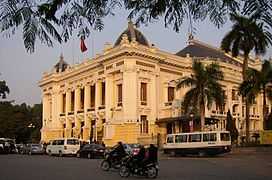Palais Garnier
| Palais Garnier | |
|---|---|
 The façade of the Palais Garnier opera house | |
| General information | |
| Type | Opera house |
| Architectural style | Second Empire and Beaux-Arts[1] |
| Location |
Place de l'Opéra, 9th arrondissement, Paris, France |
| Coordinates | 48°52′19″N 2°19′54″E / 48.87194°N 2.33167°ECoordinates: 48°52′19″N 2°19′54″E / 48.87194°N 2.33167°E |
| Construction started | August 1861[2] |
| Inaugurated | 5 January 1875 |
| Cost |
36,010,571.04 francs (as of 20 November 1875)[3] |
| Height | 56 metres (184 ft) from ground level to the apex of the stage flytower; 32 metres (105 ft) to the top of the facade[4] |
| Technical details | |
| Structural system | masonry walls; concealed iron floors, vaults, and roofs[5] |
| Other dimensions | 154.9 metres (508 ft) long; 70.2 metres (230 ft) wide at the lateral galleries; 101.2 metres (332 ft) wide at the east and west pavilions; 10.13 metres (33.2 ft) from ground level to bottom of the cistern under the stage[6] |
| Design and construction | |
| Architect | Charles Garnier |
The Palais Garnier (pronounced: [palɛ ɡaʁnje]) is a 1,979-seat opera house, which was built from 1861 to 1875 for the Paris Opera. It was originally called the Salle des Capucines because of its location on the Boulevard des Capucines in the 9th arrondissement of Paris, but soon became known as the Palais Garnier in recognition of its opulence and its architect, Charles Garnier. The theatre is also often referred to as the Opéra Garnier, and historically was known as the Opéra de Paris or simply the Opéra,[7] as it was the primary home of the Paris Opera and its associated Paris Opera Ballet until 1989, when the Opéra Bastille opened at the Place de la Bastille.[8] The Paris Opera now mainly uses the Palais Garnier for ballet.
The Palais Garnier is probably the most famous opera house in the world, a symbol of Paris like Notre Dame Cathedral, the Louvre, or the Sacré Coeur Basilica."[9] This is at least partly due to its use as the setting for Gaston Leroux's 1910 novel The Phantom of the Opera and, especially, the novel's subsequent adaptations in films and Andrew Lloyd Webber's popular 1986 musical.[9] Another contributing factor is that among the buildings constructed in Paris during the Second Empire, besides being the most expensive,[10] it has been described as the only one that is "unquestionably a masterpiece of the first rank."[11] This opinion is far from unanimous however: the 20th-century French architect Le Corbusier once described it as "a lying art" and contended that the "Garnier movement is a décor of the grave".[12]
The Palais Garnier also houses the Bibliothèque-Musée de l'Opéra de Paris (Paris Opera Library-Museum). Although the Library-Museum is no longer managed by the Opera and is part of the Bibliothèque nationale de France,[13] the museum is included in unaccompanied tours of the Palais Garnier.[14]
Construction history

The Palais Garnier was designed as part of the great reconstruction of Paris during the Second Empire initiated by Emperor Napoleon III, who chose Baron Haussmann to supervise the reconstruction. In 1858 the Emperor authorized Haussmann to clear the required 12,000 square metres (1.2 ha) of land on which to build a second theatre for the world-renowned Parisian Opera and Ballet companies.[15]
The selection of the architect was the subject of an architectural design competition in 1861, a competition which was won by the architect Charles Garnier (1825–1898). Legend has it that the Emperor's wife, the Empress Eugénie, who was likely irritated that her own favored candidate, Viollet-le-Duc, had not been selected, asked the relatively unknown Garnier: "What is this? It's not a style; it's neither Louis Quatorze, nor Louis Quinze, nor Louis Seize!" "Why Ma'am, it's Napoléon Trois" replied Garnier "and you're complaining!"[16] Andrew Ayers has written that Garnier's definition "remains undisputed, so much does the Palais Garnier seem emblematic of its time and of the Second Empire that created it. A giddy mixture of up-to-the-minute technology, rather prescriptive rationalism, exuberant eclecticism and astonishing opulence, Garnier's opera encapsulated the divergent tendencies and political and social ambitions of its era."[1] Ayers goes on to say that the judges of the competition in particular admired Garnier's design for "the clarity of his plan, which was a brilliant example of the beaux-arts design methods in which both he and they were thoroughly versed."[1]
Laying of the foundation

Initial funds to begin construction were voted on 2 July 1861,[17] and the site was excavated between 27 August and 31 December. On 13 January 1862 the first concrete foundations were poured, starting at the front and progressing sequentially toward the back, with the laying of the substructure masonry beginning as soon as each section of concrete was cast. The opera house needed a much deeper basement in the substage area than other building types, but the level of the groundwater was unexpectedly high. Wells were sunk in February 1862 and eight steam pumps installed in March, but the site would not dry up. To deal with this problem Garnier designed a double foundation to protect the superstructure from moisture. It incorporated a water course and an enormous concrete cistern (cuve) which would both relieve the pressure of the external groundwater on the basement walls and serve as a reservoir in case of fire. A contract for its construction was signed on 20 June. Soon a persistent legend arose that the opera house was built over a subterranean lake, inspiring Gaston Leroux to incorporate the idea into his novel The Phantom of the Opera. On 21 July the cornerstone was laid at the southeast angle of the building's facade. The brick vault of the cuve was finished by 8 November, and the substructure was essentially complete by the end of the year.[18]
Model

The emperor expressed an interest in seeing a model of the building, and a plaster scale model (2 cm per meter) was constructed by Louis Villeminot between April 1862 and April 1863 at a cost of more than 8,000 francs. After previewing it, the emperor requested several changes to the design of the building, the most important of which was the suppression of a balustraded terrace with corner groups at the top of the facade and its replacement with a massive attic story fronted by a continuous frieze surmounted by imperial quadrigae over the end bays.[19]
With the incorporated changes, the model was transported over specially installed rails to the Palais de l'Industrie for public display at the 1863 exhibition. Théophile Gautier wrote of the model (Le Moniteur Universel, 13 May 1863) that "the general arrangement becomes intelligible to all eyes and already acquires a sort of reality that better permits one to prejudge the final effect ... it attracts the crowd's curiosity; it is, in effect, the new Opéra seen through reversed opera glasses."[20] The model is now lost, but it was photographed by J. B. Donas in 1863.[19]
The emperor's quadrigae were never added, although they can be seen in the model. Instead Charles-Alphonse Guméry's gilded bronze sculptural groups Harmony and Poetry were installed in 1869. The linear frieze seen in the model was also redesigned with alternating low- and high-relief decorative medallions bearing the gilded letters from the imperial monogram ("N" for Napoléon, "E" for Empereur). The custom-designed letters were not ready in time for the unveiling and were replaced with commercially available substitutes. After the fall of the empire in 1870, Garnier was relieved to be able to remove them from the medallions. Letters in Garnier's original design were finally installed during the restoration of the building in 2000.[21]
Change in name


The scaffolding concealing the facade was removed on 15 August 1867 in time for the Paris Exposition of 1867. The official title of the Paris Opera was prominently displayed on the entablature of the giant Corinthian order of coupled columns fronting the main-floor loggia: "ACADEMIE IMPERIALE DE MUSIQUE".[22] When the emperor was deposed on 4 September 1870 as a result of the disastrous Franco-Prussian War, the government was replaced by the Third Republic, and almost immediately, on 17 September 1870, the Opera was renamed Théâtre National de l'Opéra, a name it kept until 1939.[23] In spite of this, when it came time to change the name on the new opera house, only the first six letters of the word IMPERIALE were replaced, giving the now famous "ACADEMIE NATIONALE DE MUSIQUE", an official title which had actually only been used during the approximately two-year period of the Second Republic which had preceded the Second Empire.[23]
1870–1871
All work on the building came to a halt during the Franco-Prussian War due to the siege of Paris (September 1870 – January 1871). Construction was far enough along that portions of the building could be used as a food warehouse and a hospital. After France's defeat Garnier became seriously ill from the deprivations of the siege and left Paris from March to June to recover on the Ligurian coast of Italy, while his assistant Louis Louvet remained behind during the turmoil of the Paris Commune which followed. Louvet wrote several letters to Garnier, which document events relating to the building. Because of the theatre's proximity to the fighting at the Place Vendôme, troops of the National Guard bivouacked there and were in charge of its defense and distributing food to soldiers and civilians. The Commune authorities planned to replace Garnier with another architect, but this unnamed man had not yet appeared when Republican troops ousted the National Guard and gained control over the building on 23 May. By the end of the month the Commune had been severely defeated. The Third Republic had become sufficiently well established by the fall, that on 30 September construction work recommenced, and by late October a small amount of funds were voted by the new legislature for further construction.[24]
1872–1873
The political leaders of the new government maintained an intense dislike of all things associated with the Second Empire, and many of them regarded the essentially apolitical Garnier as a holdover from that regime. This was especially true during the presidency of Adolphe Thiers who remained in office until May 1873, but also persisted under his successor Marshal MacMahon. Economies were demanded, and Garnier was forced to suppress the completion of sections of the building, in particular the Pavillon de l'Empereur (which later became the home of the Opera Library Museum). However, on 28–29 October an overwhelming incentive to complete the new theatre came when the Salle Le Peletier, which had been the chief venue of the Paris Opera and Ballet since 1821, was destroyed by a fire which raged the entire night.[25]
Completion

During 1874 Garnier and his construction team worked feverishly to complete the new house, and by 17 October the orchestra was able to conduct an acoustical test of the new auditorium, followed by another on 2 December which was attended by officials, guests, and members of the press. The Paris Opera Ballet danced on the stage on 12 December, and six days later the famous chandelier was lit for the first time.[26] The theatre was formally inaugurated on 5 January 1875 with a lavish gala performance. The program included the overtures to Auber's La muette de Portici and Rossini's William Tell, the first two acts of Halévy's 1835 opera La Juive (with Gabrielle Krauss in the title role), along with "The Consecration of the Swords" from Meyerbeer's 1836 opera Les Huguenots and the 1866 ballet La source with music by Delibes and Minkus.[27]
The chandelier

The 7-ton bronze and crystal chandelier was designed by Garnier. Jules Corboz prepared the model, and it was cast and chased by Lacarière, Delatour & Cie. The total cost came to 30,000 gold francs. The use of a central chandelier aroused controversy, and it was criticized for obstructing views of the stage by patrons in the fourth level boxes and views of the ceiling painted by Eugène Lenepveu.[28] Garnier had anticipated these disadvantages but provided a lively defense in his 1871 book Le Théâtre: "What else could fill the theatre with such joyous life? Who else could offer the variety of forms that we have in the pattern of the flames, in these groups and tiers of points of light, these wild hues of gold flecked with bright spots, and these crystalline highlights?"[29]
On 20 May 1896, the accidental falling of one of the chandelier's counterweights, which burst through the ceiling into the auditorium, resulted in the death of one member of the audience. This incident inspired one of the more famous scenes in Gaston Leroux's classic 1910 gothic novel The Phantom of the Opera.[28]
Originally the chandelier was raised up through the ceiling into the cupola over the auditorium for cleaning, but now it is lowered. The space in the cupola was used in the 1960s for opera rehearsals, and in the 1980s was remodeled into two floors of dance rehearsal space. The lower floor consists of the Salle Nureïev (Nureyev) and the Salle Balanchine, and the upper floor, the Salle Petipa.[28]
Recent history of the house

In 1969, the theatre was given new electrical facilities and, during 1978, part of the original Foyer de la Danse was converted into new rehearsal space for the Ballet company by the architect Jean-Loup Roubert.[citation needed]
During 1994, restoration work began on the theatre. This consisted of modernizing the stage machinery and electrical facilities, while restoring and preserving the opulent décor, as well as strengthening the structure and foundation of the building. This restoration was completed in 2007.[citation needed]
After three attempts since 1875, a restaurant opened its doors on the eastern facade of the building in 2011. L'Opéra Restaurant was designed by French architect Odile Decq. The chef is Christophe Aribert.[30]
Architecture and style

The Palais Garnier is a building of exceptional opulence. The style is monumental and considered typically Beaux-Arts, with use of axial symmetry in plan, and its exterior ornamentation. Its audience sits under a central chandelier which weighs more than six tons, and it has a huge stage with room to accommodate as many as 450 artists.
It is decorated with very elaborate multicolored marble friezes, columns, and lavish statuary, many of which portray deities of Greek mythology. Gilded galvanoplastic bronze busts of many of the great composers are located between the columns of the theatre's front façade and depict from left to right: Rossini, Auber, Beethoven, Mozart, Spontini, Meyerbeer, and Halévy. On the left and right lateral returns of the front facade are busts of the librettists Eugène Scribe and Philippe Quinault, respectively.[31]

The sculptural group Apollo, Poetry, and Music, located at the apex of the south gable of the stage flytower, is the work of Aimé Millet, and the two smaller bronze Pegasus figures at either end of the south gable are by Eugène-Louis Lequesne. The two gilded figural groups - L'Harmonie (Harmony) and La Poésie (Poetry) - crown the apexes of the principal facade's left and right avant-corps, respectively, were both designed by Charles Gumery. They are both made of gilt copper electrotype.
The bases of the two avant-corps are decorated (from left to right) with four major multifigure groups sculpted by: François Jouffroy (Harmony),[32] Jean-Baptiste Claude Eugène Guillaume (Instrumental Music), Jean-Baptiste Carpeaux (The Dance), criticized for indecency), and Jean-Joseph Perraud (Lyrical Drama). The facade also incorporates other work by Gumery, Alexandre Falguière, and others.[31]

The interior consists of interweaving corridors, stairwells, alcoves and landings allowing the movement of large numbers of people and space for socializing during intermission. Rich with velvet, gold leaf, and cherubim and nymphs, the interior is characteristic of Baroque sumptuousness.
The ceiling area, which surrounds the chandelier, contains a new 1964 painting by Marc Chagall which was installed on a removable frame over the original and depicts scenes from operas by 14 composers – Mussorgsky, Mozart, Wagner, Berlioz, Rameau, Debussy, Ravel, Stravinsky, Tchaikovsky, Adam, Bizet, Verdi, Beethoven, and Gluck. Although praised by some, others feel Chagall's work creates "a false note in Garnier's carefully orchestrated interior."[33]
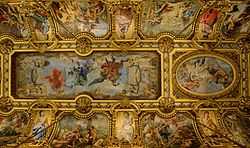
Influence abroad
The building inspired many other buildings over the following thirty years.
Several buildings in Poland were based on the design of the Palais Garnier. these include the Juliusz Słowacki Theatre in Kraków, built during 1893 and also the Warsaw Philharmony edifice in Warsaw, built between 1900 and 1901.
In the Ukraine, the influence of the Palais Garnier can be seen at the National Opera House of Ukraine in Kiev, built in 1901, Lviv Theatre of Opera and Ballet in Lviv, built between 1897 and 1900.
The Thomas Jefferson Building of the Library of Congress in Washington, D.C. is modelled after the Palais Garnier, most notably the facade and Great Hall.[34]
The Theatro Municipal do Rio de Janeiro (1909) was also modeled after Palais Garnier, particularly and Great Hall and stairs.
The Amazon Theatre in Manaus (Brazil) built from 1884 to 1896. The overview is very similar, though the decoration is more simple.
The Hanoi Opera House in Vietnam is considered to be a typical French colonial architectural monument in Vietnam, and it is also a small-scale replica of the Palais Garnier. The Saigon Opera House is a smaller counterpart.
-

Warsaw Philharmonic
-

National Opera House of Ukraine
-
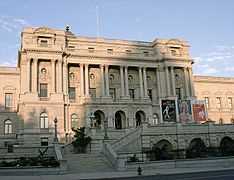
The Thomas Jefferson Building at the Library of Congress
-
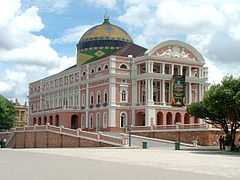
The Amazonas theater in Manaus, Brazil
-
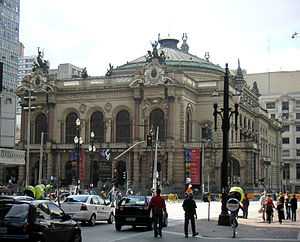
Municipal Theater of São Paulo
-

Municipal Theatre of Rio de Janeiro
Artwork
-
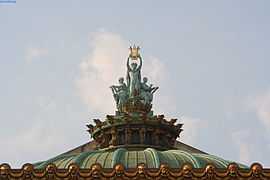
Apollo, Poetry and Music roof sculpture by Aimé Millet
-
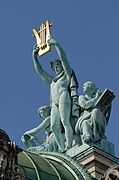
Apollo, Poetry and Music; Apollo's lyre detail
-

Poetry roof sculpture by Charles Gumery
-
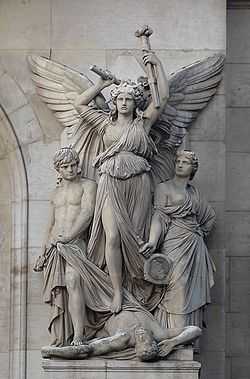
Lyrical Drama façade sculpture by Jean-Joseph Perraud
-

The Dance by Jean-Baptiste Carpeaux
-

Bronze busts of Beethoven and Mozart on the front façade
-

Marc Chagall's ceiling, repainted in a modern style and which is very different from the colour scheme of the rest of the building. At the center is the grand chandelier
-

Palais Garnier east side with L'Opéra Restaurant
See also
- Bibliothèque-Musée de l'Opéra National de Paris
- Opéra National de Paris
- Paris Opera Ballet
- The works of Paul Dubois- French sculptor
- Salle Le Peletier
- The Phantom of the Opera
- Listing of the works of Alexandre Falguière
- List of works by Henri Chapu
References
Notes
- ↑ 1.0 1.1 1.2 Ayers 2004, pp. 172–174.
- ↑ Mead 1991, p. 146. Haussmann reported on 14 August 1871 that the site had been cleared and surveyed. A temporary building for the Opéra Agence was erected in August, and excavation was begun on the 27th.
- ↑ Mead 1991, p. 197. According to this source, more work was done after this date, and some parts of the building were never completed. The figure does not include the costs of acquiring and clearing the land, which was the responsibility of Haussmann's Service d'Architecture and probably exceeded 15 million francs (Mead 1991, pp. 140, 146).
- ↑ Nuitter 1875, p. 250. Heights are measured from the ground level of the Place de l'Opéra. The sculpture at the apex of the stage flytower roof is not included, but would add an additional 7.50 metres.
- ↑ Mead 1991, p. 156.
- ↑ Nuitter 1875, pp. 249–250. The length is measured from the south side of the principal facade to the north side of the avant-corps of the administration; the widths, between the exteriors of the two lateral galleries, and the east and west pavilions; basement depth, from the ground level of the Place de l'Opéra to the bottom of the cistern under the stage house.
- ↑ Beauvert 1996, pp. 102–109 (capacity, theatre names); Hanser 2006, pp. 172 (dates of construction).
- ↑ Ayers 2004, p. 188.
- ↑ 9.0 9.1 Hanser 2006, pp. 172–179.
- ↑ Simeone 2000, p. 177.
- ↑ Watkin 1996, pp. 391–392.
- ↑ Quoted and translated in Woolf 1988, pp. 220, 233. From Le Corbusier, Almanach d'Architecture Moderne, Collection de 'L'Esprit Nouveau, Charles Eliot Norton Lectures 1938–9 (Paris, 1955), p. 120 ("art de mensonge", "événement Garnier est un décor d'enterrement").
- ↑ "Bibliothèque-Musée de l'Opéra" (in French) at the BnF website. Retrieved 3 August 2011.
- ↑ "Palais Garnier" at the Paris Opera website. Retrieved 3 August 2011.
- ↑ Beauvert 1996, pp. 102–109.
- ↑ Translated and quoted by Ayers 2004, pp. 172–174. The architectural styles mentioned by the empress were those which prevailed during the reigns of Louis XIV, XV, and XVI. For more information, see the sections on Baroque, Rococo, and Neoclassicism in French architecture.
- ↑ Mead 1991, p. 137.
- ↑ Mead 1991, p. 147; Hanser 2006, p. 174; Ayers 2004, p. 174.
- ↑ 19.0 19.1 Mead 1991, pp. 149–151.
- ↑ Mead 1991, p. 303.
- ↑ Fontaine 2000, pp. 91–92.
- ↑ Mead 1991, p. 185.
- ↑ 23.0 23.1 Levin, Alicia. "A documentary overview of musical theaters in Paris, 1830–1900" in Fauser (2009), p. 382.
- ↑ Mead 1991, pp. 142–143, 168–170.
- ↑ Mead 1991, pp. 143–145. 170–172.
- ↑ Simeone 2000, pp. 177–180.
- ↑ Huebner 2003, p. 303.
- ↑ 28.0 28.1 28.2 Fontaine 2004, p. 94–95.
- ↑ Garnier 1871, p. 205; quoted and translated in Fontaine 2004, p. 94.
- ↑ Paris Opera Restaurant Press Release
- ↑ 31.0 31.1 Fontaine 2000
- ↑ Jouffroy's group is titled l'Harmonie in Nuitter 1878, p. 11, and in Garnier 1875–81, vol. 1, p. 424, vol. 2, p. 273, but is identified as La Poésie in the "Table des planches" of the 1875 atlas folio Statues décoratives (View at Wikimedia Commons), and according to Fontaine 2000, p. 82, is also sometimes referred to as Lyric Poetry.
- ↑ Hanser 2006, p. 177.
- ↑ Scott & Lee 1993, pp. 142–145.
Sources
- Allison, John, editor (2003). Great Opera Houses of the World, supplement to Opera Magazine, London.
- Ayers, Andrew (2004). The Architecture of Paris. Stuttgart; London: Edition Axel Menges. ISBN 978-3-930698-96-7.
- Beauvert, Thierry (1996). Opera Houses of the World. New York: The Vendome Press. ISBN 978-0-86565-977-3.
- Fauser, Annegret, editor; Everist, Mark, editor (2009). Music, Theater, and Cultural Transfer. Paris, 1830–1914. Chicago: The University of Chicago Press. ISBN 978-0-226-23926-2.
- Fontaine, Gérard (2000). Charles Garnier's Opéra: Architecture and Exterior Decor, translated by Ellie Rea and Barbara Shapiro-Comte. Paris: Éditions du Patrimoine. ISBN 978-2-85822-581-1.
- Fontaine, Gérard (2004). Charles Garnier's Opéra: Architecture and Interior Decor, translated by Charles Penwarden. Paris: Éditions du Patrimoine. ISBN 978-2-85822-801-0.
- Garnier, Charles (1871). Le Théâtre. Paris: Hachette. View at Google Books.
- Garnier, Charles (1875–81). Le nouvel Opéra de Paris, two volumes text and six atlas folios (two with architectural plates and four with plates of photographs by Louis-Emile Durandelle of sculptures and paintings). Paris: Ducher. List of entries at WorldCat.
- Vol. 1, text (1878). 522 pages. View at Google Books.
- Vol. 1, plates (1880). Partie architecturale, 40 plates. OCLC 487188010 and 180042214.
- Vol. 2, text (1881). 425 pages. View at Google Books.
- Vol. 2, plates (1880). Partie architecturale, 60 plates. OCLC 487187971 and 180042222.
- [Vol. 3] (1875). Sculpture ornamentale, 45 plates. OCLC 487188045.
- [Vol. 4] (1875). Statues décoratives, 35 plates. OCLC 487188137. View at Wikimedia Commons.
- [Vol. 5] (1875). Peintures décoratives, 20 plates. OCLC 487188071.
- [Vol. 6] (1875). Bronzes, 15 plates. OCLC 487188105.
- Hanser, David A. (2006). Architecture of France. Westport, Connecticut: Greenwood Press. ISBN 978-0-313-31902-0.
- Huebner, Steven (2003). "After 1850 at the Paris Opéra: institution and repertory", pp. 291–317 in The Cambridge Companion to Grand Opera, edited by David Charlton. Cambridge: Cambridge University Press. ISBN 978-0-521-64118-0. ISBN 978-0-521-64683-3 (paperback).
- Guest, Ivor Forbes (1974). Ballet of the Second Empire. London: Wesleyan University Press. ISBN 978-0-273-00496-7.
- Guest, Ivor Forbes (2006). The Paris Opera Ballet. London: Wesleyan University Press. ISBN 978-1-85273-109-0.
- Kleiner, Fred S. (2006). Gardner's Art Through The Ages. Belmont, California: Thomsom Wadsworth. ISBN 978-0-534-63640-1.
- Mead, Christopher Curtis (1991). Charles Garnier's Paris Opéra: Architectural Empathy and the Renaissance of French Classicism. New York: The Architectural History Foundation. Cambridge, Massachusetts: The MIT Press. ISBN 978-0-262-13275-6.
- Nuitter, Charles (1875). Le nouvel Opéra (with 59 engravings). Paris: Hachette. Copies 1, 2, and 3 at Google Books.
- Nuitter, Charles (1878). Histoire et description du nouvel Opéra. Paris: Plon. View at Gallica. (Title page undated; signed by Nuitter and dated 28 November 1878 on p. 42; Gallica gives the date of publication as 1883.)
- Scott, Pamela; Lee, Antoinette J. (1993). Buildings of the District of Columbia. New York: Oxford University Press. ISBN 978-0-19-506146-8.
- Simeone, Nigel (2000). Paris: A Musical Gazetteer. New Haven: Yale University Press. ISBN 978-0-300-08053-7.
- Watkin, David (1996). A History of Western Architecture, 2nd edition. New York: Barnes & Noble Books. ISBN 978-0-7607-0252-9.
- Woolf, Penelope (1988). "Symbol of the Second Empire: cultural politics and the Paris Opera House", pp. 214–235, in ''The Iconography of Landscape, edited by Denis Cosgrove and Stephen Daniels. Cambridge: Cambridge University Press. ISBN 9780521389150.
- Zeitz, Karyl Lynn (1991). Opera: the Guide to Western Europe's Great Houses. Santa Fe, New Mexico: John Muir Publications. ISBN 978-0-945465-81-2.
External links
|
|
| Wikimedia Commons has media related to Palais Garnier. |
- Official website (in English)
- L'Opéra Restaurant (in English)
- History of architecture (in Spanish)
- Unused architectural drawings for the Opéra de Paris by Charles Rohault de Fleury
- 360° Panoramas of the Paris Opera by the Media Center for Art History at Columbia University
| ||||||||||||||||||||||||||||
| ||||||||||||||||||||
